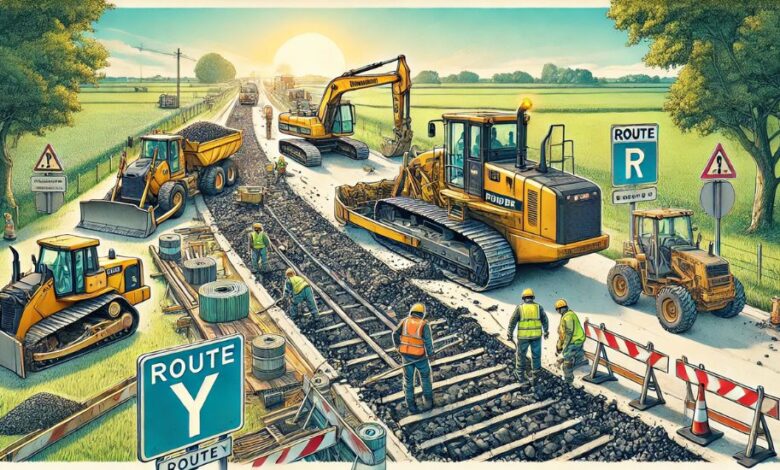Comprehensive Insights into the 2010 MoDOT FDR Route Y Project

The 2010 MoDOT FDR Route Y Project stands as a significant milestone in Missouri’s infrastructure development. As a part of the Missouri Department of Transportation’s (MoDOT) initiatives, this project utilized Full Depth Reclamation (FDR) techniques to enhance Route Y’s functionality and longevity. Insider Gists explores the project’s objectives, methodology, and long-term impact on Missouri’s transportation framework.
What is the 2010 MoDOT FDR Route Y Project?
The 2010 MoDOT FDR Route Y Project was a transformative effort undertaken to revitalize Route Y, a key roadway serving local and regional traffic. FDR, a sustainable pavement rehabilitation technique, was at the core of this project. By recycling existing roadway materials, the project aimed to address structural deficiencies while minimizing environmental and financial costs. This approach marked a shift towards modern, sustainable infrastructure practices in Missouri.
Objectives of the 2010 MoDOT FDR Route Y Project
1. Structural Improvement
One of the primary goals of the 2010 MoDOT FDR Route Y Project was to improve the structural integrity of the roadway. Years of wear and tear had left Route Y with significant issues, including potholes, cracks, and weak subgrades. The FDR method allowed MoDOT to address these problems comprehensively.
2. Cost Efficiency
Traditional road rehabilitation methods can be costly due to the need for new materials and extended labor hours. The 2010 MoDOT FDR Route Y Project aimed to reduce these costs by reusing existing materials. This innovative approach helped MoDOT allocate resources efficiently without compromising quality.
3. Environmental Sustainability
The use of FDR in the 2010 MoDOT FDR Route Y Project aligned with MoDOT’s commitment to sustainability. By recycling existing materials on-site, the project minimized the need for transporting new materials, thereby reducing carbon emissions and waste generation.
Full Depth Reclamation (FDR): A Game-Changing Technique
FDR is a rehabilitation process that involves pulverizing the existing pavement and underlying base materials. These materials are then mixed with stabilizing agents, such as cement or asphalt emulsion, to create a new, durable base layer. The 2010 MoDOT FDR Route Y Project leveraged this technique for several reasons:
- Durability: FDR creates a strong and stable base that can support heavy traffic.
- Efficiency: The process is faster and requires fewer resources compared to traditional methods.
- Adaptability: FDR can be tailored to specific roadway conditions, making it ideal for Route Y’s diverse challenges.
Key Phases of the 2010 MoDOT FDR Route Y Project
1. Assessment and Planning
Before implementing FDR, MoDOT conducted a thorough assessment of Route Y’s condition. This phase involved:
- Identifying areas with the most severe damage.
- Determining the appropriate stabilizing agents for the project.
- Developing a comprehensive project timeline.
2. Material Reclamation
The reclamation phase began with the pulverization of the existing pavement and subgrade materials. Specialized equipment was used to mix these materials with stabilizing agents, ensuring uniformity and consistency.
3. Compaction and Curing
Once the new base layer was formed, it underwent compaction to achieve the desired density. The curing process allowed the materials to harden and stabilize, creating a robust foundation for the final pavement layer.
4. Surface Paving
The final phase involved laying a new asphalt surface over the stabilized base. This step provided a smooth, durable roadway that could withstand heavy traffic and harsh weather conditions.
Benefits of the 2010 MoDOT FDR Route Y Project
Enhanced Roadway Performance
The use of FDR significantly improved the structural integrity and lifespan of Route Y. The roadway is now better equipped to handle increased traffic volumes and load demands.
Cost Savings
By reusing existing materials, MoDOT saved a substantial amount of money compared to traditional rehabilitation methods. This cost-effective approach also allowed for the allocation of funds to other critical infrastructure projects.
Environmental Impact
The project’s emphasis on sustainability reduced waste generation and carbon emissions, contributing to Missouri’s broader environmental goals.
Challenges Faced During the 2010 MoDOT FDR Route Y Project
Weather Conditions
Unpredictable weather posed a challenge during the project’s implementation. Rain and extreme temperatures occasionally delayed construction timelines.
Technical Limitations
While FDR is a versatile technique, it requires specialized equipment and expertise. Ensuring the availability of these resources was crucial to the project’s success.
Long-Term Impact of the 2010 MoDOT FDR Route Y Project
The success of the 2010 MoDOT FDR Route Y Project set a precedent for future infrastructure projects in Missouri. Its emphasis on sustainability, efficiency, and innovation has influenced MoDOT’s approach to roadway rehabilitation. Additionally, Route Y continues to serve as a vital transportation corridor, supporting local communities and regional economies.
Conclusion
The 2010 MoDOT FDR Route Y Project exemplifies how modern techniques like Full Depth Reclamation can revolutionize infrastructure development. Insider Gists celebrates this project as a testament to MoDOT’s commitment to sustainability, efficiency, and long-term roadway performance. By addressing structural deficiencies while minimizing costs and environmental impact, the project has left a lasting legacy on Missouri’s transportation network.



